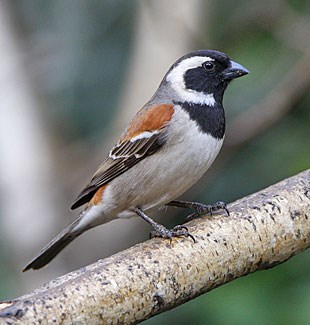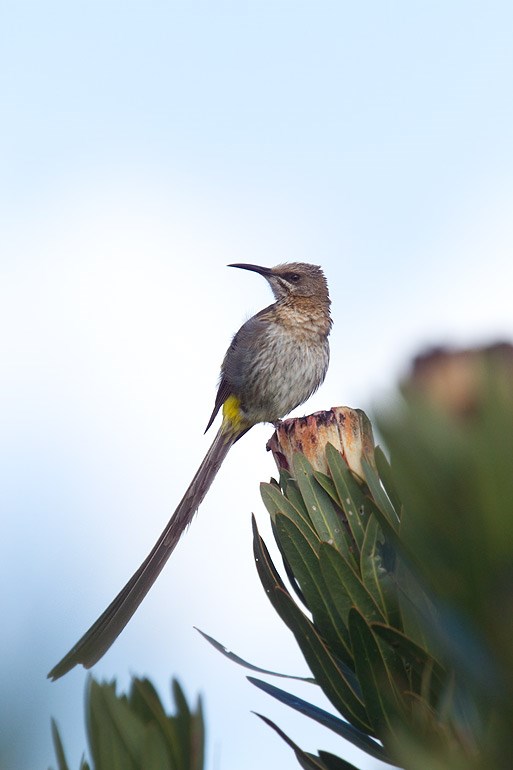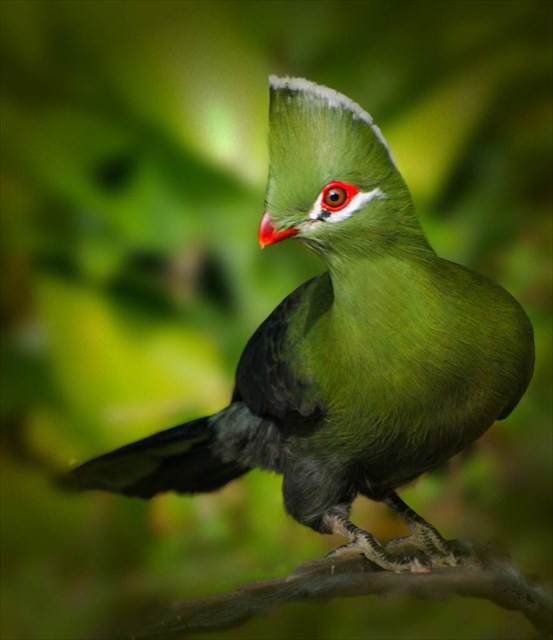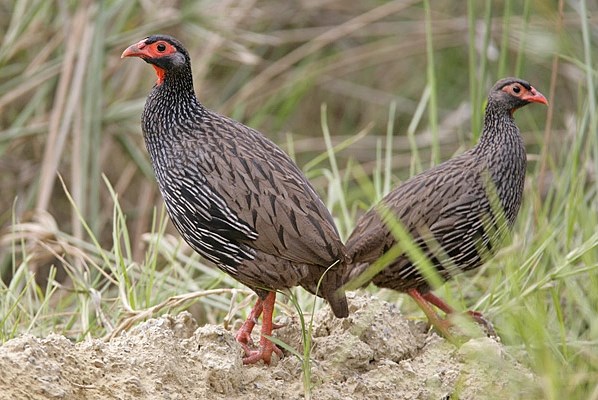Cape Crow

The Cape Crow or Black Crow (Corvus capensis) can often be seen cruising the skies around town. It feeds on a wide variety of animals and plants, such as fruits and seets, spiders, ants, snails, and other invertebrates which it digs for, Hadeda style. It likes open grassland with a smattering of trees, which they use for nesting (usually near the top). The nest consists of a large bowl of sticks and twigs, lined with softer materials such as feathers, fur and wool.
Cape Crow = 6
Cape Sparrow

The Cape Sparrow (Passer melanurus) is common all over South Africa, being seen both in cities and the wild alike. These sparrows feed on seeds, fruit, nectar and insects. Their nests are messy affairs, consisting of a hollow ball of grassy material with an entrance tunnel on the side. They nest alone, or in colonies of up to 100 pairs.
Cape Sparrow = 3
Cape Sugarbird

The Cape Sugarbird (Promerops cafer) is endemic to the Fynbos biome of the Western Cape, extending into the Eastern Cape, and Grahamstown is about as far east as you'll find them. It feeds mainly on the nectar from Proteas, and is as such a major pollinator of the protea family, visiting up to 300 flowers per day. It occasionally feeds on nectar from other plants, and catches insects in flight. A pair of Cape Sugarbird have made a nest in the shrub you'll find at one of the listed waypoints.
Cape Sugarbird = 0
Knysna Lourie

The Knysna Lourie or Knysna Turaco (Tauraco corythaix) generally keeps to forested areas, preferring Afromontane forests and riverine forest in fynbos. The louries forage in the canopies of trees for a wide variety of fruits and berries, and supplements this with seeds and invertebrates. The Knysna Lourie builds a flimsy nest of interlacing twigs in a tangle of leaves, either in the outer branches or in creepers. In the area of this cache you are unlikely to see a Knysna Lourie, but I have been fortunate enough to spot the louries on a few occasions near Dassiekrans.
Knysna Lourie = 0
Malachite Sunbird

The Malachite Sunbird (Nectarinia famosa) is found throughout most of the southern and eastern South Africa, and keeps to a variety of habitats, ranging from scrubby hillsides in mountainous areas to arid steppes of Namaqualand. It feeds mostly on nectar, but supplements its diet with small insects. It usually forages singly or in pairs, but flocks of over 100 individuals have been recorded at localised food sources. The sunbirds are solitary, territorial nesters, with the nest built solely by the female. The nest is a teardrop shaped cup constructed from dry grass bound with spiderwebs.
Malachite Sunbird = 2
Red-Necked Francolin

The Red-Necked Spurfowl, or Red-Necked Francolin (Pternistis afer), can sometimes be spotted scurrying away in the tall grass as one walks on the various trails across the commonage. A few of them have given me a fright by suddenly exploding from shrubbery I happened to be passing. The birds eat mainly invertabrates (snails, ants & other insects) in summer and fallen fruits/plant matter in winter, doing most of its foraging in the early morning and evening. They nest on the ground, hiding their nests amongst the vegetation and camouflaging it with grass.
Cape Francolin = 7
Rock Kestrel

The Rock Kestrel (Falco ripicolus) prefers open semi-arid and arid environments, such as grassland and the Karoo, as well as urban centres. During breeding season, the falcons usually keep to areas around cliffs, where they build their rudimentary nests consisting of a simple scrape in a hole or a crack, or "borrows" the nest of another bird built in similar areas (like the nests of ravens). The falcons are territorial and usually solitary nesters. The Rock Kestrel hunts for small mammals, birds and reptiles from a high perch, or by hovering in mid-air to spot prey, swooping down onto it once located. Occasionally it also hunts aerially for birds as large as the Rock Dove, which is more exhausting, but more rewarding. I've spotted a Rock Kestrel near the Yellowwood Grove.
Rock Kestrel = 9
Speckled Pigeon

The Speckled Pigeon, or African Rock Pigeon (Columba guinea) keeps to rocky, mountainous areas, but can also be found in urban areas (a breeding pair nests on a window ledge near my office every year). It almost exclusively feeds on seeds, although occasionally it will eat fruit and leaves. The pigeons nest on ledges of cliffs, building a small nest of twigs and grass, and sometimes manmade objects like wire and nails.
Speckled Pigeon = 8
The Cache
The cache can be found at S 33° 20.ABC E 026° 31.DEF. Please take care near the cache site - footing is somewhat uncertain, and snakes may favour the area. While you are doing this cache, please be on the lookout for birds, and report in your log which species you have seen so that I can update the list below.
Birds spotted while doing this cache
- Cape Crow
- Cape Sugarbird
- Cape Sparrow
- Malachite Sunbird
Source: http://www.biodiversityexplorer.org/birds/
Visit the South African Geocaching Forums and connect with geocachers in your area!
Awards
Gold: ---
Silver: ---
Bronze: ---
Tin: ---